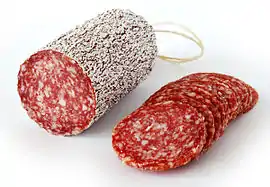Salame ticinese
Salame ticinese (also Salame nostrano) is a variety of salami originating in Ticino, the southernmost region of Switzerland. It is characterized by coarsely ground meat and it is often made into small sausages, called salametti. It is an emblematic air-dried cured pork meat of Ticino,[1] along with prosciutto crudo and coppa. These are referred to as salumi.[2]

For the production of salami, first choice meats are used. They are selected from the shoulder, nut, thigh and bacon trimmings. The lard is extracted from the fatty tissue of the back and cut into cubes. The meat is coarsely minced and seasoned with salt, saltpeter, pepper, spices and sometimes garlic and wine. The maturation of the salami can last, depending on the size, from a month up to a year or more. For the salametti instead, it takes only 8-10 days.[3]
Centuries ago, when peasants ate meat only a few times per year, salami was a luxurious product. It was not made for consumption but for sale, and it was a source of income. In the 18th century, wealthy families would hang cured meats from the bedroom ceiling, and among these, salami. In a text written in 1767, Descrizione del baliaggio di Locarno ("Description of the bailiwick of Locarno"), salami is described among other luxury foods: salsiccia affettata e cruda, detta salammi ("sliced and raw sausage, called salami").[3]
Salami was homemade until the 1970s, especially in rural contexts. The traditional slaughtering of the pig in Ticino is called mazza.[4] Today, salami is a very popular consumer product in both Ticino and Switzerland, and it is made in large meat factories.[1] Rapelli is the largest manufacturer in the country.[5] In addition to pork salami, horse, donkey, deer, and wild boar salami are also produced.[3] Local specialties include salami matured in the medieval Bellinzona Castles.[6]
See also
- Swiss sausages and cured meats
- Landjäger and Salsiz, other dried sausages from Switzerland
References
- Hofmann, Heini (17 March 2012). "Wurst ist nicht gleich Wurst: Salami – die Königin der Rohwürste" [Not all sausages are the same: salami – the queen of raw sausages] (PDF). Engadiner Post. Retrieved 10 March 2023.
Die Reifung ist ein Wesensmerkmal der Salami. Früher erfolgte sie im Naturkeller, weshalb naturgereifte Rohwürste in unseren Breitengraden nur in den Wintermonaten hergestellt werden konnten. Heute wird die Naturreifung in der Schweiz nur noch in kleinen, traditionellen Handelsbetrieben oder von Bauern im Tessin ausgeübt. Grossbetriebe sind längst zur Reifung in Klimakammern übergegangen, was eine ganzjährige Produktion erlaubt.
[Maturation is an essential feature of salami. It used to take place in a natural cellar, which is why naturally matured raw sausages could only be produced in our latitudes in the winter months. Today, natural ripening in Switzerland is only practiced in small, traditional trading companies or by farmers in Ticino. Large companies have long switched to maturing in climate chambers, which allows year-round production.] - "Salumi". Ticino Top Ten. Rezzonico Editore. Retrieved 10 March 2023.
Il salame viene prodotto con coscia, spalla di maiale e lardo, con aggiunta di sale, aromi, spezie e vino rosso nostrano. Dopo essere stato insaccato, viene asciugato per circa una settimana e quindi stagionato da 20 a 70 giorni a seconda delle dimensioni.
[The salami is made with thigh, pork shoulder and lard, with the addition of salt, herbs, spices and local red wine. After being bagged, it is dried for about a week and then aged from 20 to 70 days depending on the size.] - "Salame". Culinary Heritage of Switzerland. Retrieved 10 March 2023.
- "Cold cuts and meats". Mendrisiotto Turismo. OTR Mendrisiotto e Basso Ceresio. Retrieved 10 March 2023.
One of the most important and longest-standing culinary traditions in Ticino is the "mazza", meaning "the slaughter of pigs". This is a ritual that at one time brought families and village communities together, performed by butchers whose fame spread from settlement to settlement.
- Michel, Serge (8 May 1998). "Rapelli inaugure au Tessin l'usine de salamis la plus moderne d'Europe" [Rapelli inaugurates in Ticino the most modern salami factory in Europe]. Le Temps. Retrieved 14 March 2023.
On pourrait appeler cela le dilemme du salami. La nécessité de choisir entre un saucisson préparé dans une cave de paysan (cher, bourré de délicieuses bactéries) et un produit d'usine, propre mais insipide. Rapelli, leader suisse du salami de qualité, tente pour sa part de résoudre ce dilemme.
[You could call it the salami dilemma. The need to choose between a sausage prepared in a peasant cellar (expensive, full of delicious bacteria) and a factory product, clean but tasteless. Rapelli, the Swiss leader in quality salami, is trying to solve this dilemma.] - Bauer, Christian (31 August 2015). "Roadtrip zum besten Risotto der Schweiz". Blick. Retrieved 10 March 2023.
Eine solche Salami reift in den Kellern der Burg Montebello in Bellinzona. In der mittleren der drei Burgen haben die Salumieri von Ticinella einen idealen Ort für ihre «Salame dei Castelli di Bellinzona» gefunden. Etwa vier Wochen, je nach Wetterlage auch länger, verbringen die armdicken Würste im mittelalterlichen Gemäuer.
[Such a salami matures in the cellars of the Montebello Castle in Bellinzona. In the middle of the three castles, the Salumieri of Ticinella have found an ideal place for their "Salame dei Castelli di Bellinzona". The arm-thick sausages spend about four weeks, or longer depending on the weather, in the medieval walls.]
